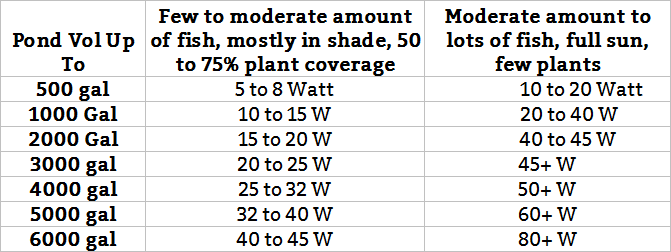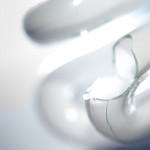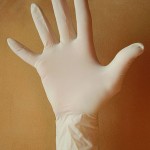Pond UV Light Buying Guide
Most of the charts that help you choose the right model uv filter, are based on the models themselves. I’ll go the other way and start with the kind of pond you have as well as your specific situation, and then help you choose a model from there.
The following chart will help you to find out which size UV light to choose. While this chart isn’t very exact, the main goals are to point out how the size of the UV light changes in relation to the amount of sunlight, fish and plants in the pond, and to roughly determine whether you need a ‘clarifier’ or a ‘sterilizer’.
Start by looking for the category in which your pond lies. (You will need to know your pond volume for this.)
If you need help determining your pond size:
In order to determine the gallons in your pond, use this easy calculation:
Length (ft) x Width (ft) x Average Depth (ft) = Cubic Feet
Cubic Feet x 7.5 = Gallons
Pond UV Filter Rough Chart

This shows you that, if your pond falls in the left category, you need a less potent UV light than if your pond is in the category to the right.
If it is in the left category, you’re looking to use a UV light as a ‘clarifier‘. This will improve water clarity resulting in a natural looking pond. While if your pond falls in the category on the right, you need to look for a ‘sterilizer‘.
You could also choose a sterilizer if your pond is in the first column, but you would do that if your mind was set on having really crystal clear water and bacterial control.
Don’t get too hooked on the actual strength or wattage that is shown. The table only gives a very rough estimation. (It also gets less accurate the more you reach the end of the 2nd column.)
Example
An example of a pond in the second column would be a well-stocked koi pond, with few plants. In general, koi ponds will require uv units two to four times larger than well planted fish ponds. To keep such ponds algae-free, even on the hottest of days, a unit is required that is graded as a sterilizer. A unit specified as a sterilizer also comes with recommendations for the right pump to combine it with.
The right pump
A pump is “right”, when its flow rate (the amount of gallons per hour it pumps) supports a high enough “turnover rate” of the pond.
If the turnover rate is not high enough, a uv light will not be able to keep up with the reproduction rate of the algae on the hottest days. This is especially true if you’re using a unit as a sterilizer. The turnover rate needs to be higher so that more water is treated in a shorter time. This makes treating the pond more efficient.
For a unit that only needs to serve as a clarifier, the standard is not as high, so a pump with a slower turnover rate is enough.
Recommended turnover rates for sterilizers are (depending on the manufacturer) roughly between 1 and 1.5 times per hour. Recommended turnover rates for clarifiers are about 0.5 times per hour (or once every 2 hours).
The thing to remember here however, is that the turnover rate of a pump is determined by the flow rate of the pump, combined with the total volume of the pond. (Example: if your pond is 500 gallons, and your pump pumps 250 gph (gallons per hour), then the turnover rate is 0.5 times per hour
About the flow rate
Every pump has a flow rate. This is the amount of water that is being pumped through the UV light. It is expressed as “gallons per hour” (gph).
If you want maximum efficiency of your UV light, the pump cannot exceed the “maximum flow rate” specified by the UV light. Do not think that you can improve performance by using a larger pump. If water goes through too fast the algae are not effected by the UV. The slower it flows through the UV light, the more effective it is. This is especially true with sterilizers, where a very slow flow is needed. The maximum flow rate of a UV light is determined by the UV power (watts) and the size of the water chamber. So the manufacturer provides the info here.
Also, do not use a pump that is not nearly powerful enough. A pump that is too small just reduces the turnover rate and might thus not be as efficient.
It is important that you choose a pump that as closely as possible matches the UV light manufacturer’s recommendations, otherwise your UV unit might end up not doing what it’s supposed to be doing.
So, how many watts do I need for my pond?
(And what pump to combine it with?)
The actual size (amount of wattage) is determined by the manufacturer and the actual specifications on the models themselves. It’s very hard to give a general amount of W for a given size of pond. This is because there’s so much difference between the models of the different manufacturers.
As a help, what follows are the recommendations of a few manufacturers:
Manufacturers recommendations:
As a clarifier:
| Manufacturer | Max size of pond | Wattage | max flow rate of pump (in gallons per hour) |
Model |
|---|---|---|---|---|
| TetraPond | 660 gal | 5 W | 330 gph | UVC-5 |
| 1800 gal | 9 W | 900 gph | UVC-9 | |
| 4400 gal | 18 W | 2200 gph | UVC-18 | |
| 8800 gal | 36 W | 4400 gph | UVC-36 | |
| PondMaster | 1500 gal | 10 W | 700 gph | 02910 10-Watt |
| 3000 gal | 20 W | 1800 gph | (discontinued) | |
| 6000 gal | 40 W | 2400 gph | 02940 40-Watt | |
| Hagen Laguna | 1000 gal | 14 Watt | 500 gph | |
| 1000-2000 gal | 28 W | 500-1000 gph | ||
| 2000-5000 gal | 55 W | 1300 gph | ||
| Aqua UV | 1500 gal | 8 W | 1000 gph | |
| 2000 gal | 15 W | 1800 gph | ||
| 4000 gal | 25 W | 2000 gph | ||
| 6000 gal | 40 W | 3000 gph | ||
| 6500 gal | 57 W | 3250 gph |
As a sterilizer:
| Size of pond | Wattage | max flow rate of pump (in gallons per hour) |
||
|---|---|---|---|---|
| TetraPond | Not specified | |||
| PondMaster | 500 gal | 10 W | 250 gph | 02910 10-Watt |
| 1000 gal | 20 W | 700 gph | (20 W model discontinued) | |
| 2000 gal | 40 W | 1200 gph | 02940 40-Watt | |
| Hagen Laguna | Not specified | |||
| Aqua Uv | 5 to 200 gal | 8 Watt | 642 gph | |
| 200 to 500 gal | 15 W | 700 gph | ||
| 500-1200 gal | 25 W | 1200 gph | ||
| 1200 to 2000 gal | 40 W | 2900 gph | ||
| 1500 – 3000 gal | 57 W | 3200 gph |
Always oversize
One rule of thumb: when doubting between 2 different wattages, always go for the stronger model.
I personally tend to oversize all my systems (pumps, filters, etc..) because I’ve noticed that it doesn’t take long before I have more fish in my pond than I intended, or before I want to make my pond bigger. It can be addictive. So when having to choose between a smaller and a larger size UV light, I suggest you go for the bigger system. There are no negative effects of having an oversized uv light for your pond.
How do you know if the bulb is faulty? Should you see the UV light?

Sometimes, after ordering, the quartz sleeve and/or the UV lamp may have been broken or damaged during the transport.
So, how do you know if the bulb is faulty?
The uv lamp will emit a blue light when it is working. Even though UV light is invisible itself, part of the spectrum of these lamps is visible in the form of blue light. In daylight this might be hard to see, so it’s a good idea to check in the evening or at night.
If you can’t see a light, then that means your lamp is faulty. Either the bulb is broken or the ballast is bad. If this a newly purchased lamp, you should be entitled to get a replacement. Contact the vendor in such a case.

Do not touch
Try not to touch the UV lamp or quartz sleeve. If you do, compounds from your skin can decrease the UV transmission once the lamp is lit. Always wear gloves when handling UV lamps and quartz sleeves to prevent premature failure and ensure optimum efficiency. If you did happen to touch the quartz, remove any marks using a clean cloth or tissue